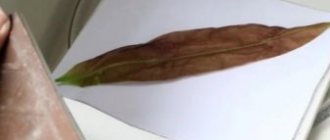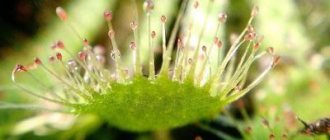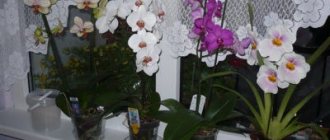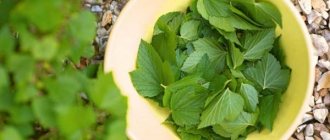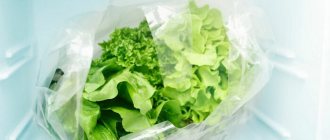Calathea attracts the attention of many gardeners due to its unusual appearance and bright greenery. With proper care, the plant will delight others with its beauty, which can outshine other species. Diseases in calathea are common, since the flower is very demanding to care for. At home, only experienced gardeners can grow the plant well. Calathea, leaves dry around the edges, what to do and how to avoid this problem - this question is asked by many flower lovers. Caring for the calathea flower at home, diseases, their treatment and prevention is the topic of this material.
Why can a plant get sick?
If we talk about a houseplant called calathea, diseases and pests can appear on it only due to improper care. This is precisely what experienced flower lovers who successfully grow various varieties never cease to repeat.
Calathea is a perennial plant up to 1.5 m high
First of all, attention should be paid to watering. Excessive soil moisture, cold or hard water are factors that can negatively affect the quality of flower growth and development. After watering, there should be no drops left on the leaves of the plant, as this is not always beneficial.
The composition of the soil also plays a significant role. Oily and rotten soil can harm the growth of calathea. The cause of rotting is almost always excess liquid that is retained in the soil due to poor drainage. If moss, mold or fungus appears on the surface, they should be removed immediately.
Another name for calathea is prayer flower or praying grass.
The condition of the flower is also reflected in the correctly chosen pot. A small container will result in slower growth. A pot that is too wide and high also negatively affects the life of the plant.
Leaves can dry out due to lack of lighting or high temperature in the room. Moreover, each plant variety requires compliance with certain rules.
Fertilizers play a special role - they must be applied according to a certain schedule, in the proportions specified by the manufacturer. When using folk remedies as fertilizers, mineral complexes must be added in much smaller quantities.
Note! An overdose of nutrients is just as harmful as a deficiency.
Location and temperature
When choosing a place to grow calathea, you need to pay great attention. In addition to lighting, this plant is greatly influenced by air movement in the room. Under no circumstances should you place a flower in a draft.
Sudden air movement can cause leaves to wilt and curl . Particularly harmful is a cold draft, in which leaves can quickly fall off. Therefore, you should not place a pot of calathea near a running air conditioner.
This flower does not like changes in location. It is not recommended to even turn it, much less move it to another place. All this affects his appearance. Leaves may also suddenly curl.
The flower also reacts quickly to sudden changes in temperature. Raising or lowering the room temperature by several degrees will certainly affect his health. It grows well in summer at temperatures of 20-24°C. In winter, the temperature may be slightly reduced: 18-20°C.
Calathea is capricious and loves stability in everything. No sudden changes in conditions during its cultivation should occur in order to maintain its health and beauty.
Calathea sheds its leaves
Pests and diseases of Chlorophytum - causes and control
Calathea can shed its leaves for several reasons. Among the main ones:
- insufficient watering;
- the appearance of pests on the flower;
- improper lighting;
- cold.
First of all, you need to make sure that there are no parasites on the flower. To do this, you should carefully examine each leaf, soil and stem of the plant. Then it is necessary to adjust the care, in particular the temperature.
Difficulties in caring for calathea at home
The beauty of the leaves of the bush is mesmerizing, but you should not buy a plant if you cannot pay a lot of attention to it and create optimal conditions. The capricious calathea requires ideal conditions, so you should familiarize yourself with its preferences.
Soil for planting
The further development and condition of the flower depends on the correct selection of soil mixture. The flowerpot should be filled with nutritious, loose and acidic soil. Alkaline soils have a detrimental effect on the flower, so it is best to purchase a ready-made substrate for arrowroot. You can make your own soil mixture from the following components:
- humus – 1 part;
- leaf soil - 1 part;
- peat – 1 part;
- river sand (calcined) – 0.5 parts.
Lighting
Under natural conditions, the flower lives under the canopy of trees, which provide it with protection from scorching rays. When kept indoors, the plant must be shaded from direct sunlight. Slight partial shade or a room with diffused light are ideal growing conditions.
However, the lack of light provokes a change in the color of the leaves, they become pale and lose their decorative effect. Excess sun often causes yellowing of foliage. The flowerpot should be placed on the west, east or southeast side. For good growth, the plant is provided with 14 hours of daylight, often using phytolamps.
Air temperature and humidity
The temperature of the room where the plant lives should be the same, without sudden changes.
If in winter the flowerpot stands on the windowsill, then it is advisable to place a thick piece of fabric under it, which will protect the root system from hypothermia.
The flower prefers high humidity, about 70%. It is very difficult to maintain such a microclimate at home, so the plant is often grown in a terrarium or florarium. If the flowerpot is on the windowsill, then regularly spray the space around the flower and only lightly spray the foliage part.
Flower growers advise wiping the foliage more often with a damp cloth, because drops of water can cause dark spots to appear. For species with velvet leaves, you should create another source of moisture - take a small tray, pour expanded clay or pebbles into it, and fill it with water. The flowerpot is placed on stones so that its bottom does not touch the water.
Watering
Water the calathea so that the substrate is constantly moist. Even a slight drought contributes to the death of the plant.
Excessive watering is also contraindicated. In addition, excess water that has flowed into the pan must be drained, otherwise the roots may rot.
For irrigation, use only warm water, which contains a small amount of lime and salts. It is best to use melt or rain water. When watering a flower with tap water, it must first be left for at least three days. It is recommended to put a little peat wrapped in gauze into the settled liquid overnight. This helps acidify the water.
Top dressing
During active development, liquid fertilizers intended for decorative deciduous varieties should be applied. The frequency of fertilizing should not exceed twice a month, because the capricious calathea is very sensitive to an excess of nutrients.
Transfer
Young plants are replanted annually after winter, and adults are disturbed no more than once every three years. To begin with, select a suitable flowerpot, which should be wide, but not deep. The reaction of the soil intended for planting should be slightly acidic.
After removing the flower from the old pot, a thick layer of high-quality drainage is poured into the new container, then a layer of fresh, moistened soil. After this, the plant is moved to a new pot using the transshipment method.
This should be done very carefully so as not to damage the sensitive roots. The resulting voids are filled with new substrate and lightly compacted.
Calathea transplant
Leaves turn pale, yellow, spots appear
Why calathea leaves turn yellow interests many gardeners. The appearance of yellowness occurs due to a lack or excess of fertilizers. Feeding calathea should take place from March to September, once every 2 weeks. From October to March once a month.
Hoya care at home, diseases and pests
It is necessary to use special fertilizers for ornamental plants. The dosage should be reduced by half from that indicated on the package.
Why calathea leaves curl is a question that can be answered if you reconsider the correct watering and air humidity parameters.
When brown spots appear on a leaf, it may indicate sunburn. Spots appear in places where drops of water remained on the leaves and the sun dried them out. To prevent this problem, it is necessary to spray the plant with a fine spray.
Attention! Moisten the plant early in the morning and in the evening so that the sun's rays do not fall on the flower at this moment.
Sometimes sticky transparent crystals appear on the back of the sheet, and at the same time the plate curls. The cause of this disease is sudden changes in temperature and humidity. In this case, it is necessary to adjust these indicators and eliminate drafts. Any cold snap below 18 °C can be detrimental to the flower.
Diseases and pests
It is worth considering the most common diseases and pests.
- The most common type of pest that attacks calathea is thrips. They appear most often when there is insufficient humidity, but in the presence of high temperatures. If the plant is spotted with light spots, it’s time to take action. The spots may change color to a darker color, after which the foliage will begin to dry out and fall off. Special means - insecticides, soap solution and fertilizing - will help to cope with the problem.
- If the plant is covered with a black film, it means that it is being overcome by sooty fungus. Film formation does not allow air circulation, disrupts photosynthesis and the plant dies. A solution of soap will help get rid of the misfortune.
- If you notice small brown insects on a flower, this is a scale insect invasion. They suck the life juices from the leaves, after which the leaves dry out. In this case, special equipment and a soap solution will help.
Another symptom that raises questions is leaf curling and drying out. This is a sign that the care of the plant has been disrupted or the placement location has been chosen incorrectly.
You should pay attention primarily to the following factors:
- high humidity;
- draft;
- sunny;
- irregular or insufficient watering.
If all these shortcomings are eliminated, the calathea will gradually return to its original state.
You can learn how to transplant calathea by watching the video below.
Calathea: leaves dry around the edges, what to do
Caring for ampelous geranium or ivy-leaved pelargonium: diseases and pests
Why calathea leaves begin to curl and dry depends on several factors. Among the main reasons are poor watering and low air humidity. It is necessary to increase the volume of watering liquid and periodically spray the flower.
If these measures do not help improve the condition of the plant, it is necessary to cut off the leaves that have begun to dry out and try to save the root system. Place the pot on moistened expanded clay and cover with a bag. When new shoots appear, the bag can be removed.
To prevent dry leaf tips, you need to monitor the air humidity.
Before answering the question of what to do if calathea leaves curl, it is necessary to establish the cause of the pathology. In most cases, the answer lies in the lack of humidity in the air around the flower. Ideally, the humidity percentage should be at least 90%. Maintaining this mode is not easy, so it is recommended to purchase a humidifier.
If it is not possible to buy such a device, you need to spray the leaves daily with filtered and settled water. You cannot use regular tap liquid, as it leaves lime stains on the leaves, which are extremely difficult to remove in the future. This rule especially applies to calathea with velvety leaves.
If a leaf begins to dry out or curl into a tube, it must be promptly removed from the plant. Lighting should be diffused and soft.
Important! Exposure to direct sunlight can have various consequences. In addition to burns, leaves often dry out, lose color, and fall off.
If the tips of the leaves of a calathea flower dry out, you need to change the location of the flower. This move seems quite reasonable and often helps to save shoots.
Leaves can curl not only due to improper care or disease. The peculiarity of calathea is that all representatives of this species curl their leaf blades at night. This is a normal phenomenon that should pass during the day.
Calathea is a very elegant flower that will fit into any interior.
Spots on calathea leaves, curling and drying of the trunk can occur due to many reasons. Before treating a plant, it is necessary to accurately determine the source of the problem, otherwise there will be no positive result.
Lighting
Incorrectly chosen lighting can not only spoil the appearance of the calathea, but also lead to its death. Both a lack and an excess of light are harmful to it.
In the wild, calathea grows under the canopy of tall trees, which prevent the sun's rays from burning its delicate leaves.
But the lighting should be diffused and bright enough. If it is deficient, variegated leaves lose color and may become uniformly green. But direct sunlight leaves burns on the leaves. Leaves curl and become covered with dry spots.
Such leaf blades are no longer restored. Without shading, especially in the summer, the plant may lose leaves and die.
The roots are rotting
The leaves of the calathea plant turn yellow, the stem and roots rot, most often due to hypothermia and excessive watering. Novice gardeners often do not know how to properly care for the fastidious calathea, so a number of problems arise.
To eliminate unpleasant symptoms, it is necessary to reduce the amount of watering and raise the air temperature to +23-28 °C.
Note! If the plant is on a cold windowsill, it must be removed from there immediately.
Home care rules
The indoor calathea flower requires special conditions. Therefore, before choosing a plant, you need to check your capabilities. The most undemanding are Calathea saffron, Calathea makoya and Calathea Bachema.
You need to deal with all the issues of caring for Calathea step by step.
Watering
For calathea, hard water is detrimental - it needs to be defended. Many gardeners use rain or melt water for these purposes. In summer, the calathea plant is demanding of water. In winter, less water is required. If for some reason there is more moisture than needed, it is poured out of the pan. If this is not done, the roots may die.
When watering flowers, you need to pay attention to the soil and the condition of the leaves. In hot weather, water three times a week, and in winter, once is enough.
Temperature and location
Flowers do not like high air temperatures. In winter, 16 degrees is enough, and in summer 18–24°C. It is advisable to maintain it constantly, since changes negatively affect the flower - the leaves wither and begin to rot. It is better to place pots away from drafts and bright windows.
The best place would be a shaded corner place, where a flower will add a special flavor to a dull interior.
Humidity
Since the calathea flower comes from tropical countries, it requires high environmental humidity:
- You can humidify the air by spraying or wiping the leaves with a damp, wet disk (only plants with glossy leaves). When carrying out such procedures, you need to know that striped calathea (zebrina) loves only boiled water.
- You can achieve the desired humidity in another way. Pebbles are poured into the tray, with sphagnum moss on top. The water will evaporate slowly, and the vapor will create the necessary microclimate.
- From time to time, spray water using a spray bottle.
Varieties with velvety leaves cannot be sprayed. It is better to bathe them in the shower twice a month. Remove dust with a dry cloth or brush.
Lighting
Calathea is unpretentious to light, but it must be placed in such a place that the daylight hours are as long as possible. Direct rays of the sun are destructive and burn.
If a good place is found, then, for example, Calathea sanderiana will delight you not only with bright leaves, but also with flowers. In order for the saffron calathea to bloom, you will need to increase the daylight hours to 10 hours. With a lack of light, the leaves turn pale and fall off.
What should the soil be like?
You can select the soil yourself or purchase a ready-made composition at a flower shop. This issue needs to be taken seriously.
The calathea flower requires special care, due to the fact that the roots are almost on the surface and spread not deep, but wide. This means the pot must be wide so that the bottom contains sufficient drainage for the plant. Otherwise, the soil will become sour.
The soil for calathea in indoor conditions should have good air permeability. This is exactly the kind of soil a flower needs in natural conditions. To do this, the soil in the pot is mixed with perlite, peat and sand. Most often the following mixture is prepared:
- peat – 1 part;
- land - 2 parts;
- sand – 1 part;
- sphagnum in small quantities;
- land from coniferous forest;
- crushed charcoal;
- dry mullein;
- currants.
Stick to a slightly acidic soil composition - pH 6. In the spring, when the plant begins to grow abundantly, it happens that the leaves dry out and curl. This means there are not enough nutrients. The first feedings begin in April and continue until August.
As a top dressing, you need to use special fertilizers for ornamental plants, without nitrogen and calcium. Read the instructions carefully: do not overfeed!
The trunk has wrinkled
The trunk of the calathea is formed from dead old leaves. In a healthy plant, it is elastic and matches the color of the leaves. There should be no stains or sticky residues.
Calathea whose trunk has shriveled needs urgent treatment. This symptom indicates that the plant is dying. If the problem is not noticed in time, the barrel may twist at an unusual angle.
This happens because the roots rot and the flower stops receiving nutrients. It is difficult to save the calathea in this case. It is recommended to cut off the crown and root it.
Caring for calathea at home
How to care for calathea
The indoor calathea flower, like all tropical plants, is heat- and light-loving, but, as they say, moderation is needed in everything: if from a lack of lighting the leaves of the calathea turn pale and lose their decorative effect, then from an excess of light the leaves become brown, which also does not add to their attractiveness . Caring for calathea involves establishing a balance of all the needs of calathea and constantly maintaining this fragile balance, therefore the best place for calathea is light partial shade, where bright sun rays do not fall. The temperature regime needs to be smooth, without sudden changes, a lower limit of 16 ºC, and no drafts!
As for soil moisture, the most important thing in this matter is the quality of water. The water for irrigation should be warm (2-3 degrees warmer than the air in the room) and soft, rain or melted snow, but if this is not available, put two or three handfuls of peat wrapped in gauze in a bucket of ordinary tap water in the evening, and in the morning this moisten the plant soil with water
Watering in the spring-summer period should be plentiful, but excess water that has leaked into the pan must be drained so that the roots are not affected by rot. In winter, watering is slightly reduced. The main principle of watering is to always keep the soil of the calathea slightly moist, but not wet.
Calathea at home, like its wild-growing relatives, needs very high air humidity, which ideally should be 90%, but since this is difficult to achieve in an ordinary house, you will have to frequently spray it with a fine spray or wipe the calathea leaves with a damp sponge. But only if you are growing a variety with smooth, hard leaves. Varieties with velvety leaves cannot be moistened by washing, so you will have to keep such specimens on a tray with wet pebbles so that the bottom of the flowerpot does not touch the water. But indoor calathea feels best in glass containers (aquariums, florariums), where high air humidity is constantly maintained.
Calathea fertilizer
In this matter, the indoor calathea plant also requires a balance: there should be enough fertilizer, but in no case more than the plant needs. Complex fertilizers for ornamental deciduous plants are used as fertilizers once every two weeks from April to August, and calathea saffron and Varshevich are fertilized with fertilizers for ornamental flowering plants.
Calathea transplant
Young calatheas require annual transplantation, adults – once every two to three years. Transplantation is carried out in the spring. The pot needs to be small and wide rather than deep. The soil for calathea should be slightly acidic, breathable and loose, as for other arrowroot or rhododendrons, and it is better to buy it in a specialized store. But if you want to make a soil mixture for calathea yourself, then you need to mix one part of humus, peat, leaf soil and half of calcined river sand.
How to transplant calathea? First, you need to place a thick layer of drainage material in the pot, then a layer of fresh soil, on which you need to carefully, trying not to destroy the earthen lump and not damage the roots, transfer the calathea, and then add so much new soil on the sides so that it fills the entire space of the pot
Pests on Calathea
If we talk about the indoor calathea flower, pests in the form of parasites are most often encountered due to various problems in caring for and growing the plant:
- Spider mite. Symptoms of the parasite include a white coating on the underside of the leaves. Over time, cobwebs become noticeable on the plant. The tick is very small and difficult to see. The leaves first turn yellow and then begin to fall off. The pest prefers dry air, so the flower must be sprayed frequently. In addition, mechanical treatment with an insecticidal agent is carried out.
- Shield. When infected, small round plaques appear on the stem and leaves. Over time, the leaves turn pale and dry out. The plant can be cured by treating it with a solution of laundry soap. To consolidate the results, it is necessary to spray with Fitoverm.
- Thrips. Small dots appear on the leaf plate, which gradually turn into spots. Small oblong-shaped insects that move in jumps are noticeable on the soil. If parasites are detected, it is necessary to rinse the plant in the shower and spray it with Intavir. To consolidate the result, you can repeat the spraying twice. The soil in which the flower is located is treated with the same solution.
Signs of plant damage by aphids
If pests are detected early, it is not difficult to combat them, since there are many insecticidal and folk remedies.
Calathea (home care, diseases, treatment are described above) is an attractive shrub that is often used as a decorative ornament. When the leaves of a calathea flower curl, what every gardener should know to do. The plant requires increased attention, and it must be grown taking into account all the rules.
Calathea flower - photo, description
The plant has a superficial root system with underground shoots from which rosettes of oval, large, unusual leaves grow. They are located on long petioles and can have a length of 30 to 40 cm. The bush itself will grow from 70 to 90 cm in height.
The plant blooms with inconspicuous flowers. The only exceptions are such types of calathea as Varschevich's calathea and saffron calathea. Their flowers are also inconspicuous, but the bracts are bright and stay on the bush for a long time. The leaves of the bracts can be pink, orange, white or cream.
The homemade calathea flower is demanding to care for, but some varieties of calathea are less demanding and grow well indoors. These types include calatheas:
- striped;
- Makoya;
- decorated;
- Evening.
Since the flower belongs to the Marantaceae, it has a common feature for this family - every evening the leaves fold and rise, and in the morning they melt and fall. For this feature, arrowroot and calathea are popularly called “prayer flowers.”
Flower propagation methods
Calathea is difficult to propagate, but if you wish and properly care for the planting material, you can get a new plant. There are three methods of propagation: dividing the bush, cuttings and using seeds.
Cuttings
It is advisable to propagate the flower using cuttings in spring. A cutting is cut from an adult plant, the length of which should be within 15 cm. The planting material should have several leaves and growth points. You can also cut a leaf, which, like the cuttings, is planted in a separate container with a damp substrate and covered with a transparent film or plastic bottle.
Dividing the bush
This is the most common method of propagation, which is carried out during transplantation. The plant is removed from the flowerpot and the rhizome is cut with a sharp sterile knife so that several full-fledged specimens with leaves and roots are obtained.
The resulting bushes are planted in separate flowerpots with a moistened substrate.
The optimal temperature is +22-24˚С. Watering and spraying should be carried out regularly and the flowerpot should be kept in partial shade. Fertilize should be done once every three weeks.
Seeds
The seed propagation method is the most difficult, because planting material has a short shelf life and poor germination. Sow the seeds in a mixture of sand and leaf soil. They are slightly buried in the ground and covered with film.
Calathea seeds
The container is transferred to a warm room with a temperature of at least +22˚С. Sprouts can be expected one month after planting.
Wrong soil
Calathea needs light soil. This is the key to her good condition and successful growth. Properly formed soil for this plant consists of a mixture of ordinary soil and pine humus in a 2:1 ratio, a small amount of coarse river sand or perlite, which make the mixture light and provide good breathability. To make the soil sufficiently nutritious, you can add a handful of horse humus to it.
If the entire plant is drying out, remove the earthen ball from the pot and check the roots. Cut off the rotten parts and transplant the calathea into another pot with the “correct” soil. Treat the flower and soil surface with Epin.
Characteristics of the variety and species diversity of Calathea
Most plant species form superficial roots, from which a short trunk grows, which is clearly visible in the photo. The internodes are located so close to each other that it seems as if the rosette of leaves is forming directly in the soil.
Large oval-shaped leaves are located on rather long petioles. Their length can reach 40 cm. The height of the bush varies between 70-90 cm. The flowering is inconspicuous, but some species, for example, Saffron and Varshevich, have decorative bracts of pink, white, orange or cream color.
The following varieties are grown as home crops:
- Calathea Bachema is considered a relatively unpretentious species. A distinctive feature of the species is the absence of stems. The long leaves (about 40 cm) are lanceolate. The leathery foliage is silvery green with a deep green pattern that runs the length of the midvein.
Calathea Bachema Calathea Makoya can reach a height of 50 cm. The broad oval foliage grows no more than 20 cm in length. The leaves are whitish in color with light green veins and dark green stripes.
Calathea Makoya Calathea painted has a dense rosette of elongated leaves, which are outlined with a dark green border. The middle of the foliage is pale green, almost white. Light green veins are located along the entire length of the leaf.
Calathea painted Calathea Veitcha is one of the most beautiful species of this genus. A large plant produces leaves of green shades with a beautiful and unusual white-green pattern. The underside of the foliage has a reddish tint.
Calathea Veitch Calathea saffron differs from its relatives in its beautiful flowering. When given full light, this variety produces orange or bright yellow flowers in midwinter. The foliage is dark green and the lower parts have a dark, almost olive tint.
Calathea saffron
How to properly care?
To prevent calathea leaves from turning yellow, curling or drying out, it is important to provide the flower with proper care.
Air humidity
Low air humidity is strictly contraindicated for Calathea. In winter, you should not place the flower near a heater or radiator. There is already arid air in our homes.
In fact, caring for this capricious plant at home involves organizing a mini-greenhouse, which should be spacious so that condensation does not form. You can also place wet expanded clay near the flower pot. Calathea is a rather moisture-loving plant. Therefore, experts recommend regularly moistening it, and the leaves can be wiped from dust with gauze or a cotton napkin.
If the cause of your bush’s illness is dry air and the leaves are very dry, try to “reanimate” the plant in this way. After spraying, immediately cover the flower with plastic without tying it up. Repeat this procedure daily.
Open the flower gradually, first for 10 minutes, gradually increasing this interval to half an hour, and after a week you can remove the plastic. The leaves will quickly gain freshness and brilliant color. Well, if it happens in winter and the room is constantly at a high temperature and the air is too dry, you will have to keep the calathea in “plastic captivity” until the heating is turned off.
Symptoms and causes
Based on the symptoms, you can determine what kind of disease has affected the flower. The signs are usually bright, it is difficult to confuse the disease if the symptoms are pronounced. When looking for the cause of diseases, refer to the following list.
- Brown spots. This is late blight. This disease affects the flower with improperly organized ventilation; the disease can also be caused by excess moisture in the soil. At the beginning of the disease, brown spots appear on the leaves, and gradually the leaves of the Kalanchoe bend upward.
- White plaque. This sign most likely indicates powdery mildew. This, unfortunately, is a common diagnosis for Kalanchoe; a fungal disease most often occurs due to too humid air in the room. At first it resembles a layer of dust, and if the gardener does not examine the Kalanchoe well, he may not attach any importance to the coating. But over time, the “dust” begins to look like flour. Because of this disease, the plant sheds its leaves and withers.
- Gray rot. If the leaves curl and rot and the plant becomes soft, then it is gray rot. This leads to mold growing on the leaves. This kind of rot is precisely gray in color, which explains the name.
- Stem rot. When Kalanchoe trunks dry out and darken, this is stem rot. First, a small black dot appears on the trunk, then it grows to such a size that the entire trunk turns black. This happens when the temperature drops sharply. If just such a phenomenon occurs in winter, the plant is in danger of death.
- Round small spots. This is probably ring spotting. And this, unfortunately, is a death sentence for the plant. It dries up and dies, so don’t wait until it completely wilts; get rid of the diseased flower as quickly as possible.
But not only diseases attack Kalanchoe. The leaves turn yellow and curl due to attack by pests. If the tops of the plant are covered with black mold, and waxy discharge appears on the leaves and stem, it is a mealybug. If the flower has almost dried out in a short time, and its leaves are constantly curling, it is probably a scale insect. The leaves turn yellow from the mite, and if the Kalanchoe first turns yellow and then drops its leaves, it is probably necessary to fight it.
Why do Kalanchoe leaves turn yellow, dry and wither?
Pathologies can be easily detected by the appearance of the culture. With the development of diseases in Kalanchoe, the leaves may turn yellow, dry out, wither or fall off. Sometimes the plant loses its ability to bloom.
A healthy flower has excellent decorative properties
These symptoms require timely initiation of treatment. Otherwise, the Kalanchoe may dry out completely.

